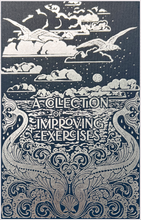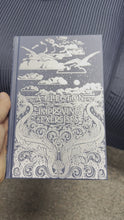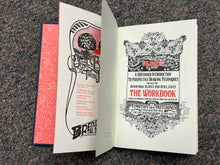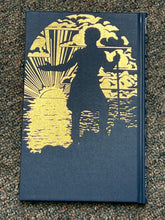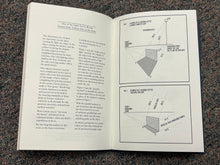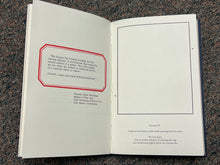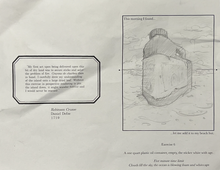
Also titled "A Continued Introduction to Perspective Drawing Techniques Suitable for Intertidal Scapes and Still Lives; the Workbook, Volume II in a Series" by Tim Hutchings, dated 1924.
Item description: The interior is printed in black and red ink. The handsome end pages are a red pattern with white dots. The book has ostentatious gilt page edges. The blue cloth hardcover has handsome designs in silver and gold foil on front, back, and spine.

***
So:
All the above is set dressing, of course. That's a fake Goodreads review. This is not actually an old book. It IS a handsome thing and I DID make it, but the Tim Hutchings mentioned in the book isn't the Tim Hutchings that is me. Not really.
Read the red text below for a more precise explanation of what you are buying. If you are 100% committed to buying a new Tim Hutchings game without risking any spoilers DON'T read the red text; just know that you are getting a handsome book with a weird game-like experience inside and trust to the fates.
A free PDF is included with all print purchases. The PDF built out of a photocopy of the book, so know it doesn't match the book exactly–it is a ratty old photocopy of the book which resembles the generations old photocopy packets I'd get in college.
Also, at this point I would like to acknowledge the editor of the book, Ezra Claverie. He made the words do the right word things and I, like a monster, didn't credit him in the book because it "wouldn't be diegetic."
crack-brained project and can assure you it is one of the
weirdest game-like objects you will ever encounter.
Highly recommended.
extremely "my jam" thing I've ever seen. I didn't know a
book of art studies could have me laugh out loud and gasp
"oh SHIT" when I realized something.
***
Spoiler-like things: This book is a diegetic trick. Of course it wasn't made in 1924. It was printed in 2023.
This is a game–of sorts. At least, it couldn't exist outside of the context of games. Like a book it can be enjoyed alone or with others, but there are no mechanical challenges that require other players. Dice are not needed. You can go through the book alone or with someone else; you can put the book down and resume it later. There are no tricks, do not cut up the spine looking for hidden clues.
This is, maybe, a perspective drawing manual. Some simple lessons are there; the shadow drawing lesson might be useful. If you are serious about perspective drawing I'd recommend you go and buy the 1962 edition of Design Graphics by C. Leslie Martin–it's how I learned and, dang, true perspective rendering is technically intense.
The fundamental activity in this game book is drawing. There are roughly one hundred drawing challenges that, generally, follow a formula of 'an item has washed up on the beach, draw it for us!' And that is it. There is more but I won't promise more.
You don't have to draw in the book, or draw at all. You can just read through it like you do with so many other game-books. It might have interesting things to say in that context as well. Interesting to me, at least.
I am very proud of this. It is a good thing, whatever it is. I wish I could find it in a used book store, put it on my own shelf for a decade, pull it down one day and discover it. I'd like to give that to you but, if you've read this far you've already forfeited that sort of experience. I applaud your caution and recommend you extend it to all parts of life.
Finally: My games are doing their own thing. This isn't a product designed to provide the most satisfying entertainment to the widest selection of people. Don't buy this expecting a definite game, or a concise experience. If you have the slightest doubt wait and hear what your trusted friends have to say. Seriously. I am an "artist" and this is art with all the capacity for shock, dissatisfaction, and risk that implies.






